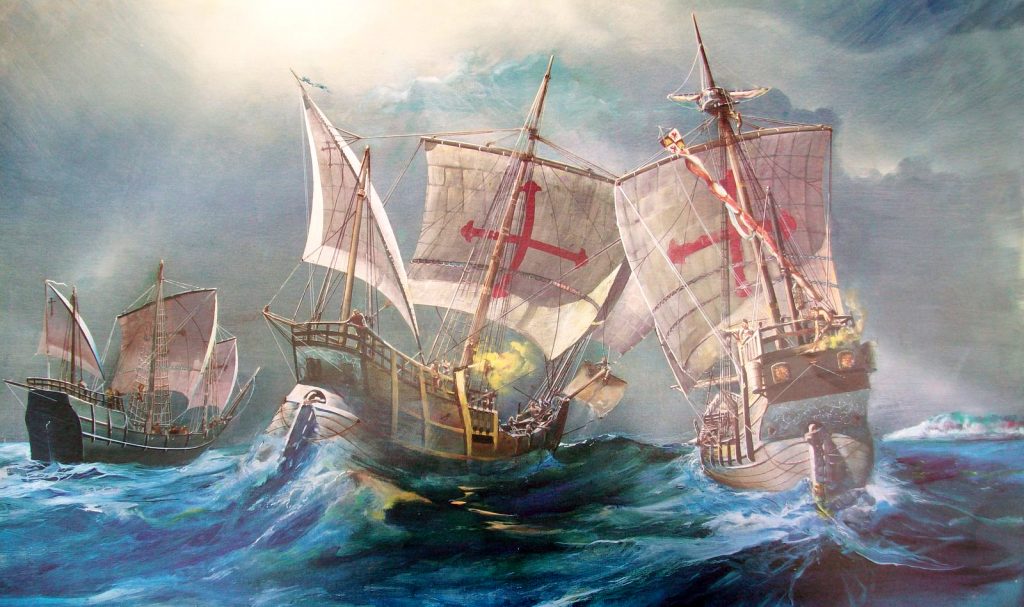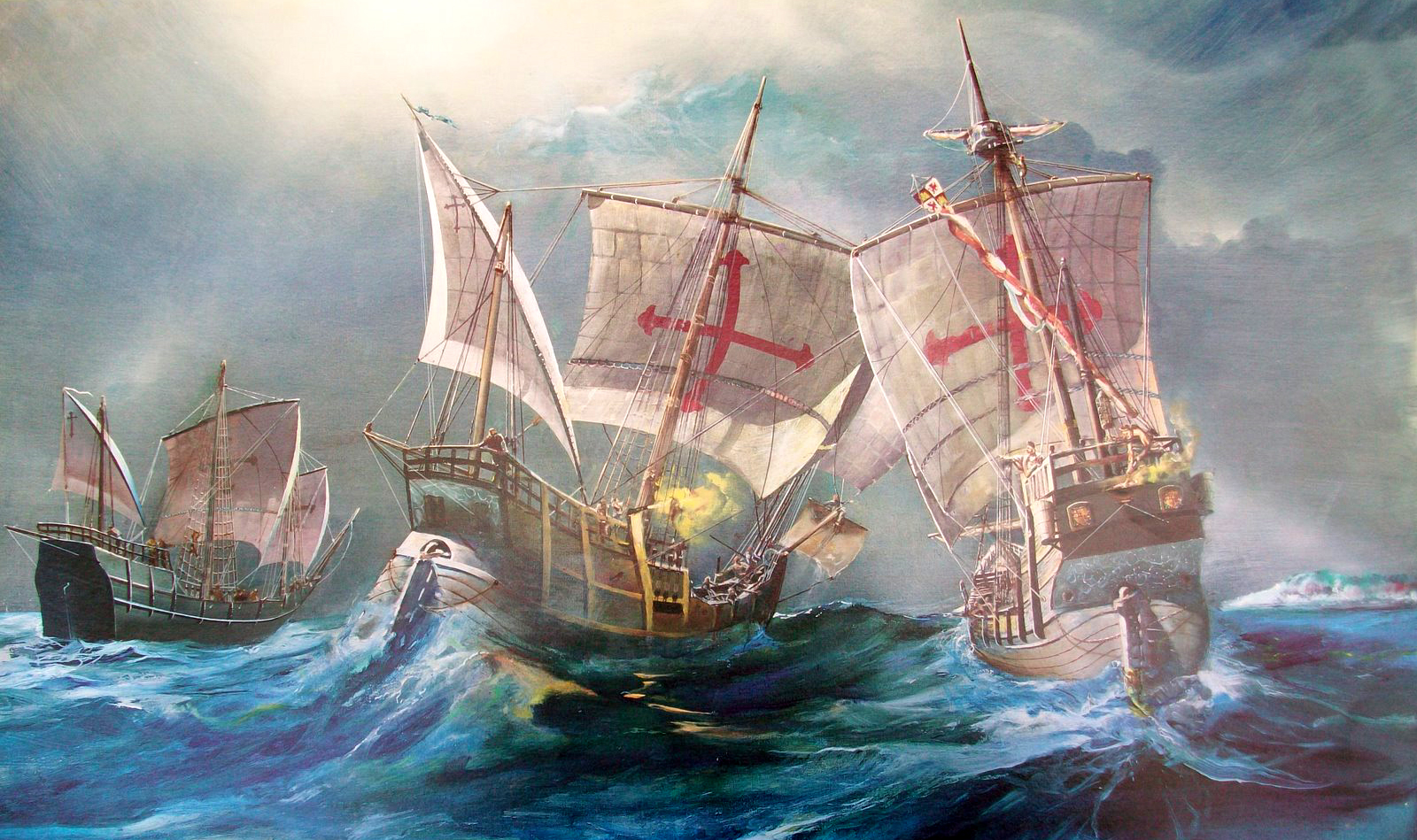Christopher Columbus was a cunning and bold Italian explorer and a master navigator of his time. He was born in 1451 in the Republic of Genoa, part of what is now Italy and went to sea as a teen to sail the Mediterranean in grand trading voyages.
His reckless ambition to explore nature and brave the ocean was only topped by his quest for gold. He almost died on his first sail into the Atlantic by cannon, musket and sword, fighting a losing battle to French pirates. Only to jump from a burning ship and survive a long nights’ swim in rough seas to the Portuguese shore.

Together, they voyaged on wooden ships in long expeditions to Africa for years. As his seamanship skills improved, Columbus learned of the Atlantic currents flowing east and west from the pirate infested Canary Islands and became enticed by the lure of Asian riches.
Spices and gold flowed from trade with Asia, but the Muslim hordes made trade routes through the Middle East a savage obstacle. Columbus knew the only solution was to go around by sea, to forge a new path.
So he studied ancient maps and learned from the tales of men about the best route to navigate west across the treacherous Atlantic. He was denounced by scholars and ridiculed by many. But he pushed forward against the haters.
Columbus devised a fleet of three majestic ships in a grand voyage west and in his early 40’s, pitched the idea to leaders of the known world, such a lavish tale that it gaining privileged audience to the King of Portugal and the ruling families of fashionable Genoa and golden Venezia.
Undeterred by their short-sighted rejection, Columbus eventually won the support of the Spanish Queen and King of Aragon who were locked in battle to push the Muslim invaders back across the straights of Gibraltar. Their funding helped build his fleet and prepare for his adventure to the other side of the world.
And in 1492, Columbus sailed the ocean blue, the Atlantic Ocean. The expedition left from Spain on a clear morning on the Santa Maria, with the Pinta and the Niña ships alongside. They carried the hope of millions as they set off to find a new route to India and the riches of the Asian islands.
After 36 arduous days at sea, Columbus and several crewmen set foot on an island in what is now the present-day Bahamas. As per the terms of his Spanish contract, he claimed the island for Spain.
Columbus and his crew successfully opened trade with the local inhabitants, exchanging glass beads, cotton balls, parrots, spear tips and gold jewelry.
When his ships and crew were replenished, he continued the expedition, landing in the islands of Cuba and Hispaniola (now Haiti) and formed trade arrangements with the leaders of the indigenous people there as well. For a time, many people prospered.
His expedition was eventually thwarted when his crown vessel, the Santa Maria, was wrecked by the reefs during a storm. But Columbus was perseverant and turned the misfortune into the wooden foundations of a new settlement, naming it Christmas Town.
Thinking his expedition complete, 39 of his crew stayed behind to settle the new town as Columbus set sail back for Spain to give a glowing report. He was warmly received by the royal court…
In 1493, Columbus took to the seas on his second expedition and explored more islands in the Caribbean Ocean. Upon return visit to Hispaniola, Columbus and his crew discovered that their Christmas Town settlement had been destroyed. All the sailors were brutally massacred.
As punishment for the murder of his crew, Columbus conscripted the locals to rebuild what they had violently destroyed and forced them to explore the island for gold as restitution for their aggression.
Before returning to Spain, Columbus left his brothers Bartholomew and Diego to govern the rebuilt settlement. But it wasn’t until his third voyage that Columbus reached the mainland, exploring the Orinoco River in present-day Venezuela.
Unfortunately, the constant attacks by the locals spurred chaos and disorder, and a lack of morale had undermined the brother’s control over Christmas Town. When news of the discontent at not finding riches reached the crown, Spain sent a militia to arrest Columbus and stripped him of his authority over the settlement. He returned to Spain in chains, a broken man, his titles stripped and his finances plundered.
But Columbus would not be deterred; he rose up and convinced King Ferdinand to fund one more glorious voyage to the new world with the promise of abundant riches.
He traveled along the coast of Central America in 1502, but was unable to find a route to the Indian Ocean. Another storm wrecked his ships and stranded the surviving sailors on Cuba; Columbus beating death once again.
At this point, the locals were no longer welcoming to their former trade partners and provided no assistance to his struggling crew. As his men slowly starved, Columbus devised an ingenious prank to fool the ignorant indigenous people.
As a wise and educated man, Columbus consulted an almanac and knowing the timing of the next eclipse, claimed that as punishment for the wanton death of his crew Columbus would take away the moon with his magic.
On February 29, 1504, a lunar eclipse greatly alarmed the natives at this show of power. Fearful of more magic, they re-established trade with the Spaniards – Columbus saving his crew, once again.
This would be Columbus’ last voyage. A rescue party finally arrived and they all returned to Spain in late November of 1504. In the two remaining years of his life, Columbus struggled to recover his lost titles and fortune.
He was partially successful in those endeavors and eventually died from complications of arthritis following an infection in May 1506. He was 55.
Columbus has been credited for opening up the Americas to European immigration – he has also been blamed for the economic and health failures of the native peoples of the islands he explored.
Ultimately, after all of his amazing accomplishments in his short lifetime, Columbus was unable to find a new route to Asia and the riches it promised.
Yet his expeditions set in motion the widespread transfer of people, plants, animals and cultures that enriched many nations and improved the lives of countless populations.
It also brought the ravage of viruses and disease, which afflicted many; An unfortunate reality that has occurred throughout the expansion and migration of humanity and continues today.
Because of Columbus, the European horse gave power and freedom to the indigenous people of the Americas which allowed them to shift from a nomadic to a more sustainable hunting lifestyle.
Wheat from the Old World became a main food source for many people, with trade in African coffee and Asian sugar becoming major cash crops for Latin American countries to grow into massive civilized nations.
Potatoes, tomatoes and corn likewise became staples for Europeans and helped thwart starvation and nourished their populations to grow.
While the overwhelming benefits of Columbus’ journeys naturally went to the Europeans, his benefactors, his accomplishments were a boon for the rest of the world.
Many civilizations were changed and lost during this period of human expansion and exploration, but it was the ambition and tenacity of the man that made him a legend in his day. It is the legacy of his spirit to continually rise and push forward into the unknown that inspires many still today.
# # #
Inspired by
https://www.biography.com/explorer/christopher-columbus





